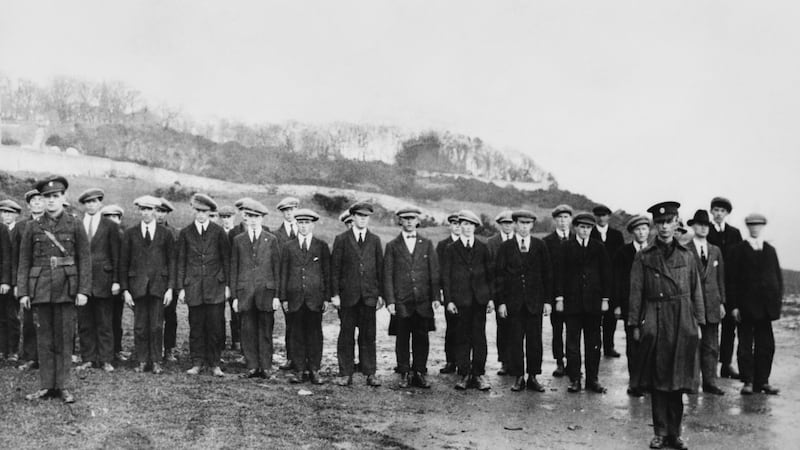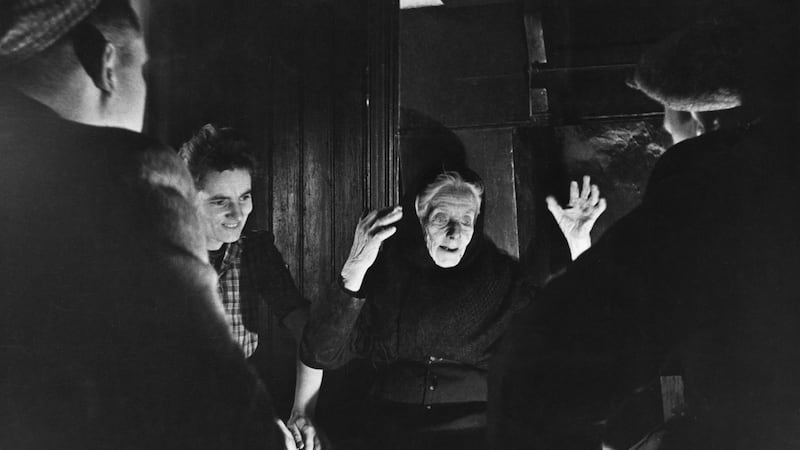At the end of October 1918 Michael Collins came out of the Sinn Féin ardfheis, at Mansion House in Dublin, with a scarf wrapped around his chin. Avoiding members of the detective division, he met with Ernie O’Malley, who at only 21 was among the most effective organisers of the volunteer companies that were becoming the IRA.
Collins took him to Cullenswood House, in Ranelagh, where Patrick Pearse had kept his first school. And there, in the dugout – a cellar or storeroom that Collins used as an office – the two of them pored over a map spread out on a big wooden table. It showed Donegal. O’Malley was being sent north. “You’ll freeze to death up there,” Collins said.
O’Malley came north. His name became Gallagher. In places people thought that Gallagher was his real name, and they called him Kelly. He was to spend four months in Donegal, mainly in the west of the county, around Ardara and Glenties, the Rosses and Gweedore, trying to put some shape on young fellows who, with scarcely any weapons, had determined to fight an empire.
“Donegal was not good,” he would later write; “the material was there, but they had no leaders . . . Inspection parades were no index of the ordinary. I knew that every effort would be made to have a good muster, men from neighbouring companies would be lent surreptitiously; a GHQ officer was an event; at councils, where I listened to and noted their reports, figures were often cooked.”
The dead walked around, there was an acceptance of their presence, no horror and little dread, the wall was thin between their living and their dead
But O'Malley liked the people, and in On Another Man's Wound, from 1936, he wrote evocatively of the conversations in the houses where he billeted: " 'A stranger' I was spoken of in their houses. It would be easy for information to be brought to the police, but though the people talked much amongst themselves, as if making up for lost time when they met, yet there were walls between them and the outside world. Tales of the Spanish Armada, ships that had been wrecked off Arranmore; stories of the O'Donnells and Fionn; ghost stories with the by-ways of elaboration so that with a wrench 'to make a long story short' they came back to the subject; spirits, good and bad, left at cockcrow. The dead walked around, there was an acceptance of their presence, no horror and little dread, the wall was thin between their living and their dead."
“The dead walked around” is a phrase that O’Malley uses elsewhere to describe “a sense of communion with the fighting dead generations” in the weeks after the 1916 Rising. But in this instance it is just a jaded representation of the west of Ireland. And it jars, for over much of the west of Ireland, and certainly here, in west Donegal, the living had been walking away from the dead since the time of the Famine. They had been doing so literally through mass migration, and they had been doing so figuratively through cultural change.

And the dying knew it. In 1936 Seán Ó hEochaidh, a 23-year-old finding his feet as a folklore collector, came to the parish of Ardara with an Ediphone, a cumbersome phonographic machine, to record old-timers. He spent much of his time in the mountain-shadowed townlands in the south of the parish where Irish was still the language of the home. There, on a frosty November night, Wee Paddy McGill, a schoolmaster, brought him out to Áighe, 3km south of the town, where he introduced him to two elderly women, Róise Nic an Ghoill, who was 72, and her sister, Máire, 10 years her senior, who sang songs and told stories that they had heard in childhood from na seandaoine, the old people. The McGills are remarkable people, Ó hEochaidh wrote in his diary; they all have songs and they think everybody else should have too. Over the next few years Ó hEochaidh returned several times to record Máire and Róise, particularly the latter, who had the better voice. And on one visit, in July 1937, Róise related some poignant anecdotes of singers dying, lamenting that their songs would die with them:
“Tháinig Séamas ’ac a Ghoill isteach anseo oidhche amháin agus ní raibh astoigh ach triúir nó ceathrar . . .
"Séamas McGill came in one night, when there was only three or four of us here – myself and a brother of mine and another neighbour man – and he started to sing – Irish songs – and he sang from nightfall until it was the time of the long sleep ["second sleep"?], and when he was going, 'Well,' says he, 'I am away, and I am dying,' says he, 'and all that is upsetting me,' says he, 'is that I am leaving nobody behind me who will have my songs.' Four days after that he was dead. He never went visiting again . . . Máthair Phádaí John Thaidhg, when she was dying, the neighbours gathered in the evening she died, and she sang a song for the family, and when she had sung the song she said was afraid that her family had none of her songs, and that is all that was bothering her as she lay dying. The last song she sang was Coinleach Glas an Fhómhair."
'Coinleach Glas an Fhómhair', the song Máthair Phádaí John Thaidhg sang on her deathbed, is a love song, its sexual yearning serrated by political longing
Máthair Phádaí John Thaidhg. The mother of Paddy, son of John, son of Teague. Time and the decline of the old naming system have done their work. Nobody can today identify Pádaí John Thaidhg, so his mother cannot be fixed in time. One can only guess that she was of a generation before that of Róise Nic an Ghoill, born in 1864, who told her story, and that she died in the first decades of the 20th century. Coinleach Glas an Fhómhair, the song she sang on her deathbed, is a love song, its sexual yearning serrated by political longing. Addressing a cáilín donn, a brown-haired girl, the singer describes her crossing the green stubble, the infield where oats have just been harvested, and cattle will now graze. She is beautiful – red cheeked, with tight curls – and she is utterly beyond him, belonging to a higher social rank. She wears shoes, and she has a stately walk, and farmers with tall ricks in their haggards – Protestants, perhaps – are wooing her. His only hope is that the king of Spain's fleet will descend on Ireland. Then he would scatter all challengers, and he and his cáilín donn would buy cattle at fairs and drive them across the Gweebarra.

It would be convenient, if poor history, to have the reference to the king of Spain precisely date the song to the 1730s or 1740s, the last decades when deliverance was expected from that quarter. But, certainly, Coinleach Glas an Fhómhair comes out of the time before potatoes had fully displaced oatmeal in the diet, when buailteachas, or booleying, was still a feature of the land system. In that time, a century before the Great Famine, young men and women used to drive their cattle away from their corn after May Day, and up into the mountains, where they would spend the summer. Then, in autumn, they would bring the herds down to the lowlands to graze the stubble, and the great cattle fair of Magheramore marked the end of the year.
Here potatoes had replaced oatmeal as the staple diet only in the latter half of the 18th century. The decline of booleying was associated with that transition and also with a more rigorous approach to estate management that involved mountain townlands’ being settled and cultivated; potatoes would grow where grain would not. It was associated too with the development of towns like Ardara and Glenties and the coach-stop hamlets of Fintown, Doochary and Dungloe, watering holes for men and horses and not much else. Around Ardara the last redoubts of booleying were in the mountains in the south of the parish, part of the Murray Stewart estate, where it continued into the 1870s. But in some places in the district the practice may not have made it into the 19th century.
The potato-based economy had been little more than a century in the making when the blight came, and it survived little more than a century after it
Coinleach Glas an Fhómhair, then, belongs to a world that had been doubtless mourned in the decades before the Famine by old people who had grown up eating more arán coirce, or oat bread, and brachán, or stirabout, than they tasted in their later years – that is, people whose youthful summers had been spent in the mountains. The potato-based economy had been little more than a century in the making when the blight came, and it survived little more than a century after it. The grain- and cattle-based economy that had preceded it had existed from time immemorial. Its demise was epochal. And so, paradoxically, while Coinleach Glas an Fhómhair was sung by a woman grieving for all that would die with her, the song itself, as a production of a prior mode of living to that which she lamented, attests to continuity through times of great change.
All had never been lost – not in the transition from oats to potatoes, nor the ending of booleying, nor the “squaring of the farms”, when the rundale system was abolished. But Máthair Phádaí John Thaidhg had seen the demographic collapse and cultural derangement that had followed the Famine, and the pitching of her people into the global economy. She had seen enough to know that a time was coming in which there would be no remembrance of former things. And Róise Nic an Ghoill, who, in 1937, remembered what that woman had sung on her deathbed, knew it too.
This article incorporates an adapted extract of Breandán Mac Suibhne's The End of Outrage: Post-Famine Adjustment in Rural Ireland (Oxford University Press), which Christopher Kissane reviews here





















